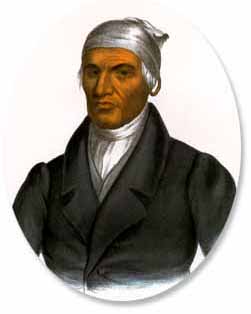
Portrait of Ca-Ta-He-Cas-Sa, or Black Hoof, a chief of the Shawnee tribe. Little is known about his early years. Allied with the French, he was present at the defeat of Edward Braddock during the French and Indian War. He did fight at the Battle of Fallen Timbers and represented the Shawnee at the signing of the Treaty of Greeneville. After this Black Hoof became convinced that the Indians had no hope against the whites except to adopt their customs. Using his influence with the Shawnee, Black Hoof encouraged the Shawnee to adopt the whites' way of living. By 1808, his followers established farms at Wapakoneta (Ohio). Conflicts between the Shawnee and settlers continued. In 1826, Black Hoof led several hundred Shawnee people to the Kansas territory. After leading his followers to Kansas, Black Hoof returned to Wapakoneta and died there in 1831.
Second Chief Black Hoof, son of the celebrated Principal Chief Black Hoof, was born in Ohio around 1795. It is Second Chief Black Hoof for whom Black Hoof Park in Lenexa is named. Second Chief Black Hoof was educated in Ohio schools and was the prominent chief of the Shawnee when he moved to Kansas in 1832. He married Na-Nex-Se at the Shawnee Indian Mission in 1843. Na-Nex-Se is the namesake of the City of Lenexa. Together they farmed property near 71st and Switzer Road. In 1854 elected chiefs and council replaced the hereditary form of tribal government. Black Hoof was one of the last hereditary leaders of the tribe and one of the first elected chiefs. The new form of tribal government elected a head chief, second chief, council and sheriff. Black Hoof was a devout Christian and beloved by all who knew him. He was a respected counselor in tribal affairs. He was one of eight delegates chosen to represent the tribe in Washington, DC to negotiate and sign the Treaty of 1854 that diminished the 1,600,000 acre Shawnee Reservation to 200,000 acres giving each man, woman and child of the Shawnee Tribe a 200 acre allotment. Around 1855, Black Hoof died in Johnson County before receiving his allotment (had he lived he would have received 640 acres per terms of the Treaty because of his, “important services to the Shawnee Nation” rendered in the past.) Na-Nex-Se continued to farm her 200 acres until removal of the Shawnee to the Cherokee Nation in Oklahoma in 1870.
[Information obtained by Bertha Cameron (Shawnee Tribe Member) and Lee Ann Martin (Black Hoof descendant)]
Resources : National Archives Microfilm; Methodist Mission Stewards Book, (KSHS)
“Beginning of the West” (KSHS)
1854 Treaty; “The Shawnees and Their Neighbors 1795-1870” by Stephen Warren pub. 2005
Chief Quasky Black Hoof, pg 1 (Legler Barn Museum)
Na-Nex-Se Black Hoof, Parks and Recreation Dept. 2001 pg. 3 (Legler Barn Museum)
Cache is hidden off the paved trail below Lake Lenexa dam in Black Hoof Park. While following the path you will come across a “horizontal tree”. You can follow the deer trail from there.Terrain rating is based on distance from parking and slight uphill grade to cache and back up the dam.
Good luck and happy caching.